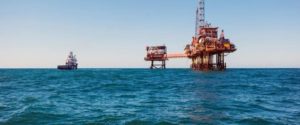 The COVID-19 pandemic, 2020 crude oil price crash and ongoing global petroleum supply glut have done little to slow the growth of South America’s massive offshore oil boom. The colossal oil boom underway in the tiny South American nation of Guyana is gaining momentum, while Suriname is on the cusp of experiencing its own and the region’s largest economy Brazil is now the world’s tenth largest oil producer. It is their booming offshore oil industries which will be responsible for South America becoming the world’s leading offshore petroleum producing regions, even surpassing North America. Despite the COVID-19 pandemic and 2020 oil price crash, Brazil’s offshore oil industry experienced strong growth. Annual average hydrocarbon output grew 5% year over year to barrels of oil equivalent daily. It was Brazil’s pre-salt oilfields and national oil company Petrobras’ focus on developing those ultra-deep-water fields which was responsible for that healthy growth. Pre-salt oil output soared by almost 18% to 2.6 million barrels daily to make up 69% of Brazil’s total hydrocarbon output. Petrobras announced its best-yet operational results, including record exports and annual average oil production of 2.28 million barrels per day. For January 2021, Brazil’s national oil company’s exports reached a new peak of 19.3 million barrels through its Angra dos Reis terminal.
The COVID-19 pandemic, 2020 crude oil price crash and ongoing global petroleum supply glut have done little to slow the growth of South America’s massive offshore oil boom. The colossal oil boom underway in the tiny South American nation of Guyana is gaining momentum, while Suriname is on the cusp of experiencing its own and the region’s largest economy Brazil is now the world’s tenth largest oil producer. It is their booming offshore oil industries which will be responsible for South America becoming the world’s leading offshore petroleum producing regions, even surpassing North America. Despite the COVID-19 pandemic and 2020 oil price crash, Brazil’s offshore oil industry experienced strong growth. Annual average hydrocarbon output grew 5% year over year to barrels of oil equivalent daily. It was Brazil’s pre-salt oilfields and national oil company Petrobras’ focus on developing those ultra-deep-water fields which was responsible for that healthy growth. Pre-salt oil output soared by almost 18% to 2.6 million barrels daily to make up 69% of Brazil’s total hydrocarbon output. Petrobras announced its best-yet operational results, including record exports and annual average oil production of 2.28 million barrels per day. For January 2021, Brazil’s national oil company’s exports reached a new peak of 19.3 million barrels through its Angra dos Reis terminal.
Unflagging demand from China, even at the height of the global pandemic, was responsible for Brazil’s strong 2020 performance. Latin America’s largest oil producer, by the end of 2020, was the fourth largest petroleum supplier to the world’s second largest economy. This can be attributed, in part, to the January 2020 introduction of IMO2020 which significantly reduced the sulfur content of maritime fuels causing the popularity of Brazil’s pre-salt Buzios and Lula crude oil varieties to soar. It is the attractive economics of Brazil’s pre-salt oil region which will drive greater investment and production growth. Many of those assets are pumping sweet medium grade crude oil at a breakeven price of $35 per barrel or even less, making them highly profitable in an operating environment where Brent is expected to average $60 to $70 per barrel.
Start Trading On OPC Markets Today Petrobras has committed to investing $55 billion between 2021 and 2025 of which 84.5% or $46.5 billion will be directed to exploration and production activities with $8.1 billion being spent on E&P in 2021. The national oil company plans to spend 70% of its five-year $46.5 billion E&P budget, which is $33.5 billion, on its pre-salt oilfields with $13 billion earmarked for the Campos Basin and $11.7 billion on the Buzios oilfield in the Santos Basin. Even after selling a significant portion of its shallow water and non-core assets Petrobras’ oil production will average 2.3 million barrels daily by 2025, which is 3% greater than 2020. Foreign energy majors are also investing in Brazil’s pre-salt oilfields alongside Petrobras because of the favorable economics. Industry consultancy Rystad Energy predicted Brazil’s crude oil output will reach an average of over 3.5 million barrels daily over the medium to long-term.
It is not only Brazil’s petroleum industry which is attracting considerable investment and driving higher regional hydrocarbon production. Offshore Guyana is experiencing its own major oil boom with particularly low estimated breakeven prices of anywhere between $23 to $35 per barrel boosting the attention the former British colony is receiving from energy investors. Global oil supermajor Exxon has made 18 oil discoveries in offshore Guyana since the start of 2015 and estimates that it has over eight billion barrels of recoverable crude oil resources. Despite drilling two dry wells during November 2020 and January 2021 in the Kaieteur and Stabroek blocks, Exxon is pressing ahead with its exploration plan in offshore Guyana. The oil supermajor, last month, spudded the Bulletwood-1 well in the Canje Block which could hold more than 500 million barrels of oil equivalent. Canje borders the prolific Stabroek Block as well as offshore Suriname blocks 58, where Apache and Total have made four discoveries since January 2020 and 42 where operator Kosmos has planned an exploration well for 2021. The 2020 approval of Exxon’s Payara development and the start-up of Liza 2 in the Stabroek block will see the oil major pumping at least 750,000 barrels daily by 2026.
Suriname’s state-controlled oil company and hydrocarbon regulator Staatsolie expects the former Dutch colony to be producing crude oil offshore by 2025. According to industry consultancy GlobalData the Maka Central-1 field in Suriname offshore Block 58, Apache’s first discovery in the Guyana-Suriname Basin, holds at least 300 million barrels of crude oil. There is speculation from analysts and industry insiders that the oilfield could be even larger than Exxon’s Liza reservoir in the Stabroek block which holds over 800 million barrels of crude oil. Apache expects to be pumping crude oil from Block 58 by around 2025.
While Brazil, Guyana and Suriname are the leading offshore drilling jurisdictions in South America, nearby Colombia is hoping to join the fray. The Andean country is struggling to kickstart its hydrocarbon sector since the 2020 COVID-19 pandemic lockdown ended. Part of Colombia’s initiatives to bolster economic growth along with crucial hydrocarbon reserves was to implement a new framework for its offshore petroleum industry during 2020. The energy ministry claims to have secured $1.6 billion of investment in offshore oil and natural gas projects for Colombia. That will not only bolster the Andean country’s oil and natural gas reserves but drive greater production, particularly with Bogota focused on attracting further investment in the economically crucial petroleum industry. Like Guyana, Suriname and Brazil, offshore Colombia offers attractive economics with the Natural Resource Governance Institute estimating an average breakeven price of $31.77 per barrel. When coupled with Bogota’s favorable petroleum industry policies and political stability, Colombia should successfully coax offshore investment from international energy companies.
The volume of offshore oil discoveries in Latin America has risen steadily since 2012, according to consultancy IHS Markit, to see the volume of conventional oil reserve discoveries being made predominantly offshore. For these reasons, industry consultancy GlobalData, in a November 2020 media release, claimed South America’s offshore oil production will overtake North America’s offshore oil output by 2024. Rystad expects South America to lead the post-pandemic recovery of offshore, primarily because of the region’s advantageous economics with Brazil and Guyana earmarked to receive over a third of all offshore oil investment between now and 2025. For these reasons South America’s offshore hydrocarbon output will soar over the coming years, seeing it potentially become the world’s leading offshore drilling region.
Source: https://oilprice.com/Energy/Crude-Oil/Is-This-The-Worlds-Next-Big-Offshore-Oil-Region.html




0 Comments